- Home
- Tennessee Williams
Vieux Carre
Vieux Carre Read online
BY TENNESSEE WILLIAMS
PLAYS
Baby Doll & Tiger Tail
Camino Real
Candles to the Sun
Cat on a Hot Tin Roof
Clothes for a Summer Hotel
Fugitive Kind
The Glass Menagerie
A House Not Meant to Stand
A Lovely Sunday for Creve Coeur
Mister Paradise and Other One Act Plays
Not About Nightingales
The Notebook of Trigorin
Something Cloudy, Something Clear
Spring Storm
Stairs to the Roof
Stopped Rocking and Other Screen Plays
A Streetcar Named Desire
Sweet Bird of Youth
27 Wagons Full of Cotton and Other Plays
The Traveling Companion and Other Plays
The Two-Character Play
Vieux Carré
THE THEATRE OF TENNESSEE WILLIAMS, VOLUME I
Battle of Angels, A Streetcar Named Desire, The Glass Menagerie
THE THEATRE OF TENNESSEE WILLIAMS, VOLUME II
The Eccentricities of a Nightingale, Summer and Smoke,
The Rose Tattoo, Camino Real
THE THEATRE OF TENNESSEE WILLIAMS, VOLUME III
Cat on a Hot Tin Roof, Orpheus Descending, Suddenly Last Summer
THE THEATRE OF TENNESSEE WILLIAMS, VOLUME IV
Sweet Bird of Youth, Period of Adjustment, The Night of the Iguana
THE THEATRE OF TENNESSEE WILLIAMS, VOLUME V
The Milk Train Doesn’t Stop Here Anymore, Kingdom of Earth
(The Seven Descents of Myrtle), Small Craft Warnings, The Two-Character Play
THE THEATRE OF TENNESSEE WILLIAMS, VOLUME VI
27 Wagons Full of Cotton and Other Short Plays
THE THEATRE OF TENNESSEE WILLIAMS, VOLUME VII
In the Bar of a Tokyo Hotel and Other Plays
THE THEATRE OF TENNESSEE WILLIAMS, VOLUME VIII
Vieux Carré, A Lovely Sunday for Creve Coeur, Clothes for a Summer Hotel,
The Red Devil Battery Sign
POETRY
Collected Poems
In the Winter of Cities
PROSE
Collected Stories
Hard Candy and Other Stories
One Arm and Other Stories
Memoirs
The Roman Spring of Mrs. Stone
The Selected Letters of Tennessee Williams, Volume I
The Selected Letters of Tennessee Williams, Volume II
Where I Live: Selected Essays
TABLE OF CONTENTS
Introduction by Robert Bray
Production Notes / Cast List
The Setting of the Play
Vieux Carré
“This house is empty now.” Tennessee Williams at 722 Toulouse in 1977. © Christopher R. Harris; all rights reserved.
INTRODUCTION
In the winter of 1938, with his B.A. degree from the University of Iowa finally in hand, Tom Williams began a post-academic education that would forever alter the course of his personal and professional life. Stultified by life back in St. Louis and hopeful of securing Depression-era Federal Writer’s Project employment, Williams decided to chance his fortune in New Orleans. A second, more strategic decision was formed out of desperation and disingenuousness. En route to New Orleans, the aspiring playwright visited his maternal grandparents in Memphis and from their home mailed off some one-act plays as well as the full-length Spring Storm to the Group Theatre playwrighting contest in New York City. But there was a catch. In order to qualify for any possible award, contestants had to be twenty-five years old or younger, so Williams changed his birth date from 1911 to 1914 and adopted an unusual nom de plume reflective of his east Tennessee paternal ancestry. Thus reinvented, the aspiring playwright followed the Mississippi River south to what he would come to call his “spiritual home”—the Vieux Carré of New Orleans.
Although a youthful Tom Williams had traveled to New York City and throughout Europe, nothing had prepared him for the exotica of the French Quarter, with its old-world charm, balmy atmosphere, and eccentric inhabitants. Many first-time visitors immediately fall in love with the Vieux Carré, but it is difficult to overestimate the impact of this geographic and cultural transition on the impressionable Williams. Many years earlier a fellow Missourian, Samuel Langhorne Clemens, underwent a strikingly similar metamorphosis, albeit in a different locale. Just as Mark Twain discovered an unconventional lifestyle, a new name, and fresh material by moving out west, and eventually to the bohemian sector of San Francisco, Tennessee Williams’s semitropical relocation marked the beginning of an artistic awakening and a period of vigorous self-discovery. Williams arrived in New Orleans on December 28, and after wandering through the Vieux Carré for only about three hours, he came back to his room and wrote, “Here surely is a place I was made for if any place on this funny old world.” After he had spent a week in various lodgings, Williams moved into a third floor apartment at 722 Rue Toulouse, signing in as “Tennessee Williams—Writer.” Even though he roomed there just longer than a month, the boarding house remained a fixture in his imagination for decades, a creative well from which he would draw one-acts, stories, poems, and the full-length Vieux Carré.
Recent scholarship has challenged conventional notions about the play’s evolution. Because Vieux Carré was not produced until 1977, traditional thinking placed it as a late organic fulfillment of his short story, “The Angel in the Alcove” (1943). Moreover, since Vieux Carré falls into Williams’s category of “memory plays,” and because we are drawn to the Writer’s apparent sense of nostalgia, it has seemed logical to assume that the author penned the play from the temporal distance of several years, if not decades. However, an examination of working manuscripts demonstrates that Williams relied less on memory than was previously suspected. In a paper presented at the 1999 Tennessee Williams Scholars’ Conference in New Orleans, Williams specialist Linda Dorff exploded conventional notions about the play’s evolution by tracing the working script back to January of 1939—the actual time that Williams lived at 722 Rue Toulouse. True to most of the playwright’s work, the drama metastasized over several years and through various phases and titles, including Dead Planet, the Moon! (working title in 1939), I Never Get Dressed Till After Dark on Sunday (written during the 1960s), and Broken Glass in the Morning, or Skylight (a version also from the 1960s written expressly for Joanne Woodward and Paul Newman but never performed by them). Williams said that he turned his full attention back to Vieux Carré in 1973 while on an ocean cruise. Working through radically different drafts over the next few years, he prepared a Broadway version in 1977. Although the play was a crashing failure and closed after only five performances, Daily News critic Douglas Watt wrote that “we must cheer this late new flowering of the author’s genius.” Walter Kerr blamed the production’s failure on the “appalling stage direction” and the “monstrously shabby physical design” but acknowledged that the play had poetic power. The following year Vieux Carré moved to London for two separate productions, but neither met with critical or commercial success. Williams wrote further changes after the London productions, and the New Directions text exists as the culmination of these various metamorphoses.
Despite the harsh critical consensus and the relative neglect from which the play has suffered, in many respects Vieux Carré deserves attention as the quintessential Tennessee Williams drama, a virtual miniature of all his other work. The atmosphere is even more redolent of New Orleans than Streetcar, the characters form a pathetic (and bathetic) human tapestry familiar to any Williams devotee; and many of the major recurring themes—the impingement of the past upon the present, the lingering effect of loss, the tribulatio
ns of the alienated artist, the undeniable necessity of human communication, and the inconsolable condition of loneliness—structure and inform the dramatic action. These Williams “signatures” were not lost on one whimsical but incisive New Orleans reviewer, who summarized (in local dialect) Vieux Carré as follows: “It’s like the other Tennessee Williams plays set in the Quarter. Da chicory’s on da stove, da cockroaches are on da walls, and all da characters are on da de-cline.”
Apparently, such was the actual condition of the roomers at 722 Rue Toulouse. Talking with William S. Burroughs the very day of the 1977 Broadway opening of Vieux Carré, Williams said that “the events in the house did actually take place. . . . There are two characters in it, a boy and a girl, whom I knew later in another house, not in that one. But all the others were there at 722 Toulouse Street, in 1939.” Although Williams’s amalgamating prowess virtually precludes one’s determining the specific source for a particular character, the importance of these 1939 friendships and associations should not be underestimated because ineluctable elements of their personalities, “fading but remembered,” resurface in Williams’s dramatis personae elsewhere. Therefore, the haunted boarding house of this late play looms paradoxically as both the genesis and final resting place for Williams’s lost and tortured lonely hearts—or, to borrow a phrase from T. S. Eliot, the end is in the beginning.
For example, so many of Williams’s vulnerable, wispy females, from Blanche to Alma to Hannah, reverberate in Jane, the boarder with whom the Writer shares his most sympathetic understanding. Like Mrs. Hardwicke-Moore in The Lady of Larkspur Lotion, Jane awaits financial salvation via a Brazilian businessman; however, as with Blanche’s Shep Huntleigh in Streetcar, this potential savior exists as an illusion born out of desperation. Jane, who describes herself as “the Northern equivalent of a lady, fallen, yes but . . . not a whore,” suffers from an unnamed progressive blood disease, but perhaps even more detrimental is her unhealthy dependence on Tye, a despicable strip show barker. Tye exudes the animal magnetism of a Stanley Kowalski but has the moral scruples of a Chance Wayne. Tye McCool exists as Williams’s classic, parasitic street hustler—coarse but alluring, with fidelity to no one. Furthermore, his casual description of how the Champagne Girl is horrifically gnawed to death by the mob boss’s dogs demonstrates his utter insensitivity to the predatory forces in life, and Jane’s inability to “unTye” herself shows how the human heart can be betrayed by carnal desire.
Another cubicle houses the blood-spitting, tubercular Nightingale, surely the most dissolute of the Quarter’s assorted habitués. A quick-sketch artist who prostitutes not only his artistic talent, the Nightingale represents the kind of human effluvium both responsible for and victimized by his own circumstances. In addition, he partners with the Writer to perform the first unambiguous homosexual liaison Williams ever staged, an act that requires (at least in the Writer’s mind) absolution by the angel in the alcove. The Nightingale also shares striking similarities with Lot, the tubercular, effeminate homosexual of Kingdom of Earth—again, suggesting that the people Williams initially met in the Vieux Carré would inspire characters several decades later.
Williams’s two beloved crones, Mary Maude and Miss Carey, are as amusing as they are pathetic, and this equilibrium testifies to Williams’s masterful control of tone. While Mary Maude apologizes for her delinquent rent payments, the delusional Miss Carey reminds everyone about her aristocratic uptown New Orleans ancestors. In the meantime, they forage for spoiled food in garbage cans and otherwise depend on Mrs. Wire’s inconsistent “kindness” for weekly nourishment.
Presiding over all this mayhem is the voyeuristic, omnipresent Mrs. Wire, modeled after Williams’s 1939 landlady Mrs. Anderson. As her name indicates, Mrs. Wire (the actual name of a later 1941 landlady) is coarse and brittle as well as intolerant and bullying—until she lapses into a confused daydream in which she mistakes the Writer for her long-lost son Timmy, proving that even the most unsentimental of Williams’s characters can be vulnerable to the haunting past. Her pouring scalding water on the party below (which actually happened and was, according to Williams, the residence of the well-known photographer Clarence John Laughlin) seems as comical as it does cruel, and the farcical night court scene provides a delightful conclusion to this outrageous episode. Even though the various characters’ misfortunes dominate the play’s action, Williams balances this adversity with equal parts humor so that almost every glimpse into a partition of despair yields the contrapuntal balance of verbal or even slapstick comedy. As they struggle against the naturalistic forces around them, “grace under destitution” might be the motto for these financially marginalized and spiritually bankrupt roomers.
The Writer, in a narrative role similar to Tom in The Glass Menagerie, frames the events and provides occasional asides that illuminate situation and character. Moreover, virtually all of the action centers on this fresh initiate’s rite of passage into the chaos of 722 Rue Toulouse. Suspended between his narration and participation, the Writer remains in relative limbo throughout the entire play. Although he is the object of the Nightingale’s sexual advances, a surrogate son for Mrs. Wire, and a confidant to Jane, his stubborn reticence precludes any sustained interaction with the other characters. In addition, the Writer’s recurring withdrawal into the introspection of his craft complements the pattern of escape that characterizes the physically and psychologically vanquished borders of 722.
It should not be surprising to consider that in a holistic sense the Writer has escaped the entrapment of the Wingfield household in The Glass Menagerie only to reemerge at the rooming house of Vieux Carré. Consummately bored by employment at the shoe warehouse in St. Louis and forced to endure life in an endlessly suffocating household, the narrator flees America’s heartland and ends up baptized by its most European city. Of course, here and elsewhere the autobiographical parallels are stubbornly obvious. When asked by an interviewer what first brought him to New Orleans, Tennessee Williams said, “St. Louis.” Even though just shy of twenty-seven, Williams might not have been completely aware of his true sexual orientation. But viewing life through the prism of the Vieux Carré opened entirely new vistas of self understanding. This initiation into the desire and disorder of the Quarter profoundly influenced his sensibilities—easily seen when Williams, as the Writer, records: “Instinct . . . directed me here, to the Vieux Carré of New Orleans . . . I couldn’t have consciously, deliberately, selected a better place than here to discover—to encounter—my true nature.” Furthermore, as he tells Mrs. Wire, “I ought to pay you—tuition!” His matriculation in the Vieux Carré coming to an end, the Writer somewhat reluctantly yields to Sky’s siren-like clarinet as he trembles at the chaotic uncertainty of his future. (Actually, Williams departed the boarding house for California with his clarinetist friend Jim Parrott on the Monday before Mardi Gras.) In any case, as with Tom’s unsuccessful attempt to extinguish his memory of Laura in Menagerie, the inference at the play’s conclusion seems to be that the Writer will become a wanderer bound for a different climate but destined to be haunted by Jane and the other inhabitants of the boarding house.
During a photo shoot for People magazine in 1977, Tennessee Williams returned to 722 Rue Toulouse. His visit could not be described as pleasurable, however, because the extensive renovations to the house disturbed him profoundly. The building’s roof had been lowered to what architects considered its original height, converting Williams’s former third floor quarters to attic air conditioning space. Ironically, efforts to restore and preserve the exterior of the ancient building had destroyed the interior as Williams remembered it. The staircase, however, was still intact—that winding ascent that some forty years ago transported those lost souls to their respective cubicles of despair. And looking over his shoulder, in the “lighter gray of the alcove with its window over Toulouse Street,” Tennessee Williams might still have been able to trace the faint outline of the angel in the alcove blessing the spiritual residue of tho
se long-departed misfits.
Robert Bray
STAGE SETTING FOR THE NOTTINGHAM PLAYHOUSE PRODUCTION BY VOYTEK
The Nottingham Playhouse Production of Vieux Carré was presented at The Playhouse Theatre, Nottingham, on May 16, 1978 and at the Piccadilly Theatre, London, by Ian B. Albery for Calabash Productions Ltd., on August 9, 1978. It was directed by Keith Hack; stage design was by Voytek, lighting by Francis Reid, costumes by Maria Björnson, and music by Jeremy Nicholas; company stage manager, James Gill. The cast in order of appearance was as follows:
MRS. WIRE
SYLVIA MILES
NURSIE
NADIA CATTOUSE
THE WRITER
KARL JOHNSON
JANE
DI TREVIS
NIGHTINGALE
RICHARD KANE
MARY MAUDE
BETTY HARDY
MISS CARRIE
JUDITH FELLOWS
TYE
JONATHAN KENT
PHOTOGRAPHER
ROBIN MCDONALD
SKY
JACK ELLIOTT
TIME: The period between winter 1938 and spring 1939.
PLACE: A rooming house, No. 722 Toulouse Street, in the French Quarter of New Orleans.
THE SETTING OF THE PLAY: The stage seems bare. Various playing areas may be distinguished by sketchy partitions and doorframes. In the barrenness there should be a poetic evocation of all the cheap rooming houses of the world. This one is in the Vieux Carré of New Orleans, where it remains standing, at 722 Toulouse Street, now converted to an art gallery. I will describe the building as it was when I rented an attic room in the late thirties, not as it will be designed, or realized for the stage.
It is a three-story building. There are a pair of alcoves, facing Toulouse Street. These alcove cubicles are separated by plywood, which provides a minimal separation (spatially) between the writer (myself those many years ago) and an older painter, a terribly wasted man, dying of tuberculosis, but fiercely denying this circumstance to himself.

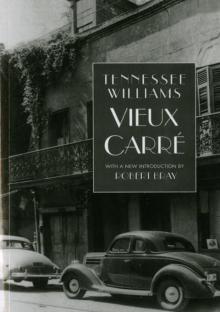 Vieux Carre
Vieux Carre The Night of the Iguana
The Night of the Iguana A Lovely Sunday for Creve Coeur
A Lovely Sunday for Creve Coeur Sweet Bird of Youth
Sweet Bird of Youth Streetcar Named Desire
Streetcar Named Desire The Milk Train Doesn't Stop Here Anymore
The Milk Train Doesn't Stop Here Anymore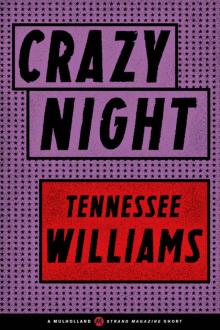 Crazy Night
Crazy Night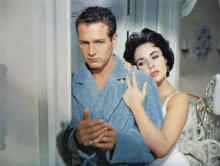 Three Plays of Tennessee Williams
Three Plays of Tennessee Williams A House Not Meant to Stand
A House Not Meant to Stand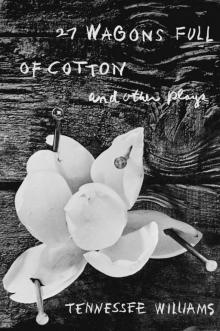 27 Wagons Full of Cotton and Other Plays
27 Wagons Full of Cotton and Other Plays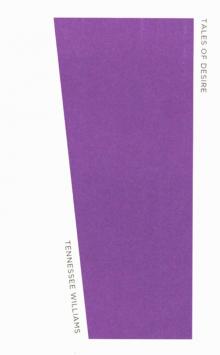 Tales of Desire
Tales of Desire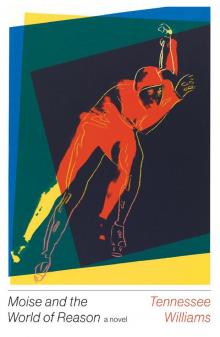 Moise and the World of Reason
Moise and the World of Reason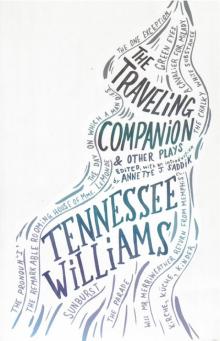 The Traveling Companion & Other Plays
The Traveling Companion & Other Plays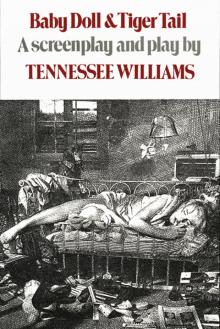 Baby Doll Tiger Tail: A Screenplay and Play by Tennessee Williams
Baby Doll Tiger Tail: A Screenplay and Play by Tennessee Williams Memoirs
Memoirs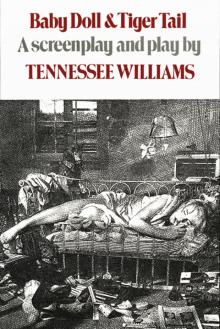 Baby Doll & Tiger Tail
Baby Doll & Tiger Tail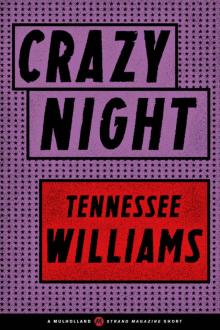 Crazy Night (A Mulholland / Strand Magazine Short)
Crazy Night (A Mulholland / Strand Magazine Short) Orpheus Descending and Suddenly Last Summer
Orpheus Descending and Suddenly Last Summer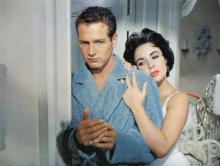 Three Plays
Three Plays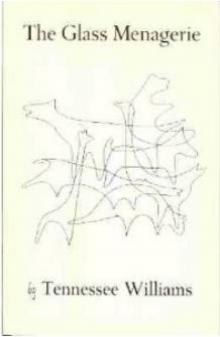 The Glass Menagerie
The Glass Menagerie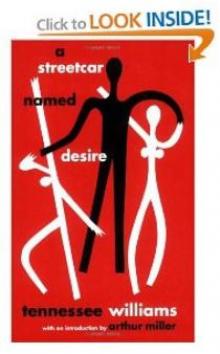 A Streetcar Named Desire
A Streetcar Named Desire